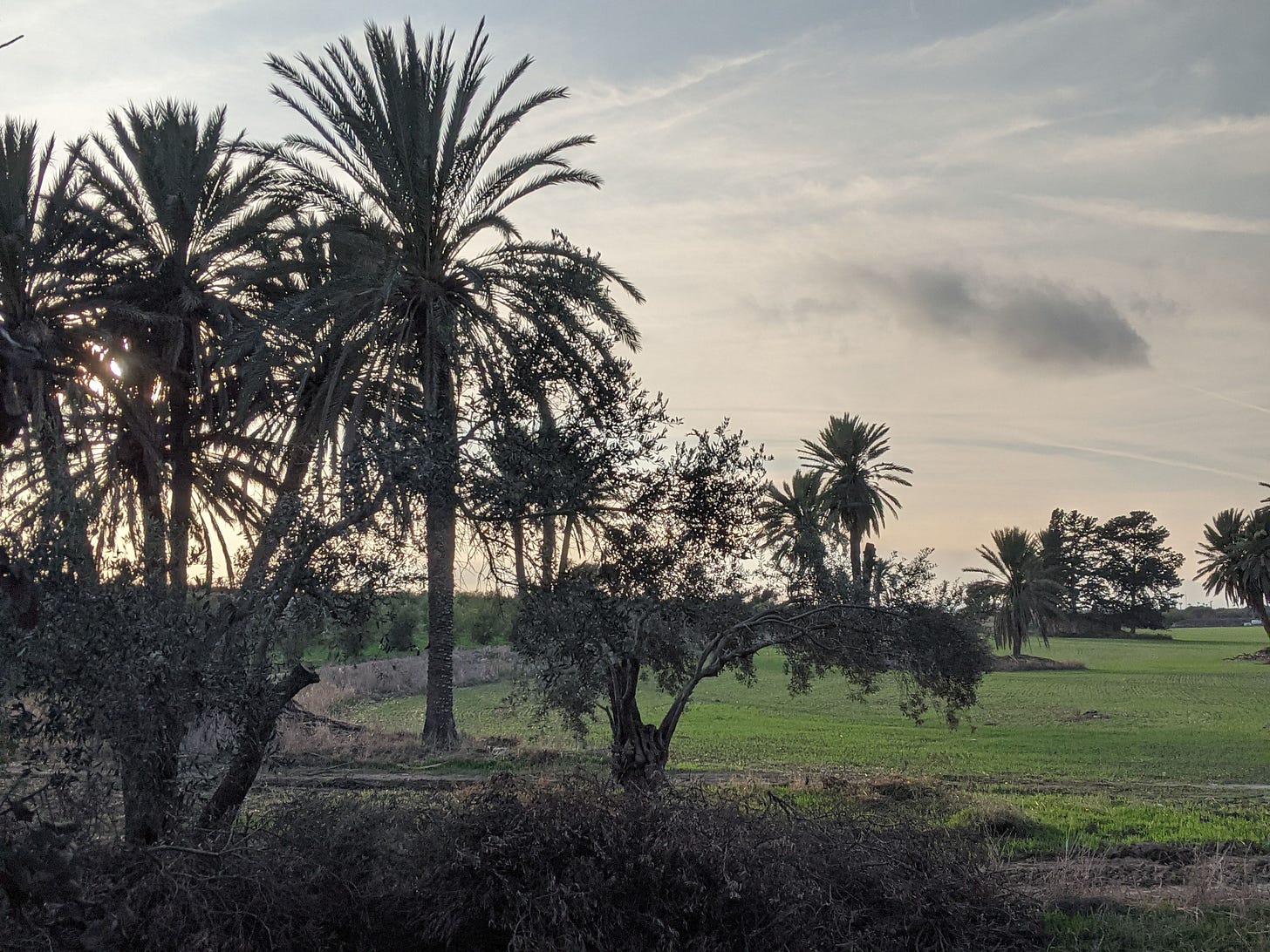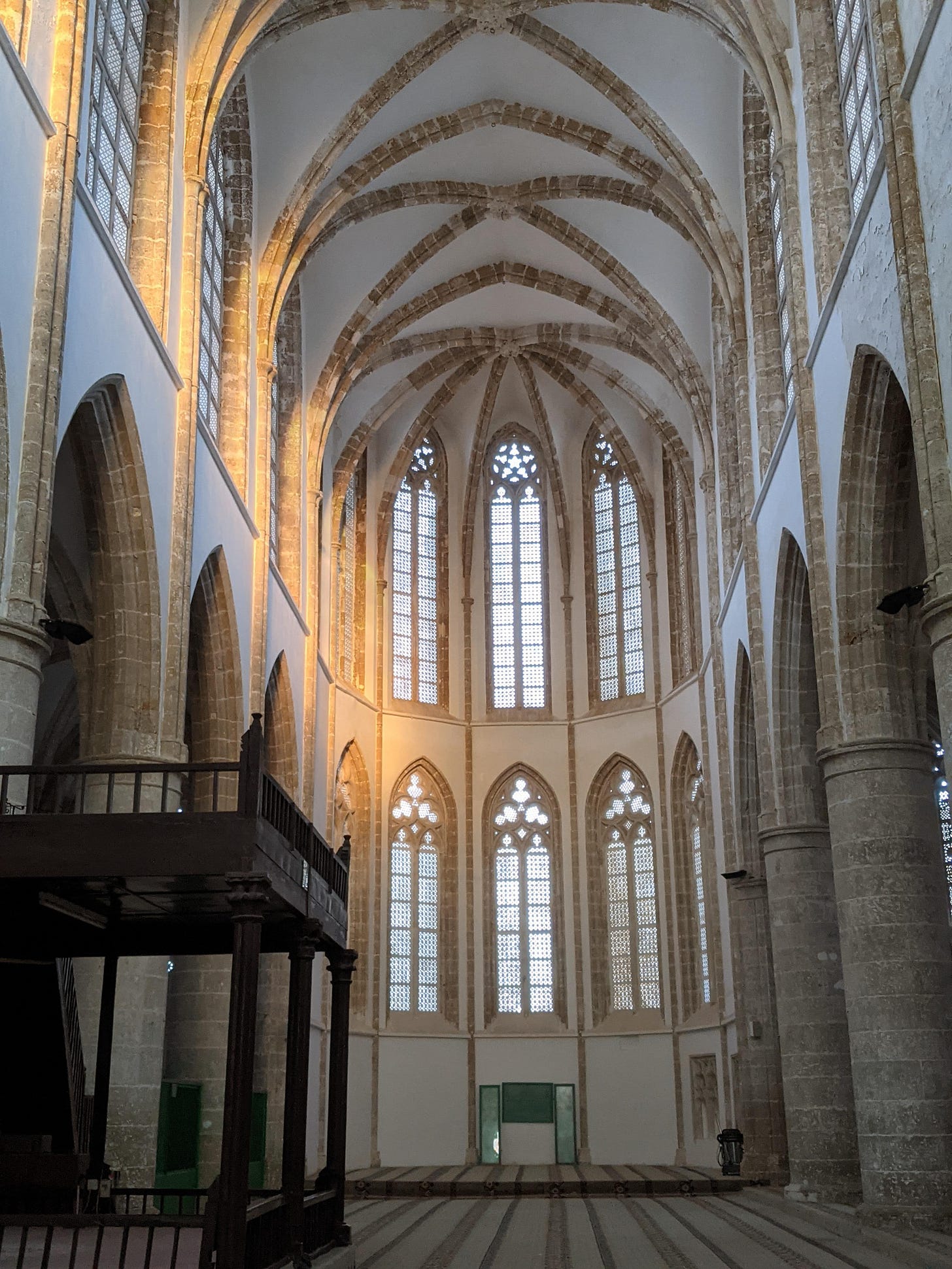Four holy sites in Cyprus
Adjacent to the holy land, a microcosm of world religious history

“As is in the course of the ages all the peoples of history have met in Cyprus, it is not strange that Cyprus has also been the meeting place of the mythical traditions relating to their worships.”
So wrote Christos Charalambous, a schoolmaster at Pancyprian High School, in a 1947 British travel guide of Cyprus edited by L. & H. A. Mangoian.
Cyprus, as an island adjacent to the Holy Land, has naturally born witness to some of the major movements in religious history. From the dawn of polytheism to the rise of Christianity and Islam, many religious monuments dot the landscape.
In this post, we’ll take a look at four interesting examples of Cypriot religious heritage—the temple of Aphrodite at Amathus, the Church of Saint Lazarus in Larnaca, the Hala Sultan Tekke Mosque in Larnaca, and the Lala Mustafa Mosque / Cathedral of Saint Nicholas in Famagusta.
The Temple of Aphrodite at Amathus
Amathus was a city of antiquity on the coast, near present-day Limassol. Tradition held that Aphrodite, the goddess of love, was born of the sea-foam near Paphos, and here at Amathus was a temple dedicated to her worship.
Aphrodite’s worship came to Cyprus from the Near East in the form of Astarte, a goddess of the Phoenicians related to the Babylonian goddess Ishtar. (More on Aphrodite in an upcoming post.) Marble was not available in Cypriot quarries, so the temple was made of the most abundant building material—sandstone. The religious activities at Amathus were apparently so important in Roman times that “Amathusia” often became a stand-in for the term, "Cypriot.”
Today, Amathus is an excavated site just a short drive from booming Limassol, a quiet reminder of a long-lost time.

The Church of Saint Lazarus in Larnaca
Being brought back from the dead, it goes without saying, might ruffle some feathers. According to tradition, after Jesus resurrected Lazarus, he was run out of town in Judaea—there were plots against his life. (Imagine being brought back from the dead and being surrounded by people who just wanted to kill you all over again).
So Lazarus came to Cyprus (an alternate tradition claims he moved to Marseille, France). He needed a job, and Paul and Barnabas got him one—the Bishop of Kitium. He lived for thirty more years before his second and final death. It is said that he never smiled after his resurrection—not after witnessing the suffering he had seen in the underworld.
Lazarus was buried in Larnaca. His remains were transferred to Constantinople in 890 CE in exchange for the construction of the Church of Saint Lazarus on the site.
The Church of Saint Lazarus is still in operation today; the Ottomans sold the facility back to the Greek Orthodox Church in 1589, after the Ottomans ousted the Catholics there in association with the Venetian defeat.
When I visited in November 2021, tourists were climbing into the alleged empty sarcophagus of Saint Lazarus and taking photos in the pose of a corpse. Thus Lazarus lives on in a third Instagram variation.

The Hala Sultan Tekke Mosque in Larnaca
The Lady Umm Haram occupies a fascinating place in Cypriot history. The aunt of the prophet Muhammad (the foster sister of his mother), Umm Haram was a wealthy and adventurous woman who lived to a great age.
According to tradition, one night when the prophet stayed in the home of Umm Haram, he had a dream of his companions sailing on the sea “as kings.” Haram was intrigued—she was apparently interested in sailing.
So it was in 694 CE, long after the prophet’s death, when the Arabs were launching a naval attack on Cyprus, that Umm Haram, now in her eighties or nineties, joined the strike force. At Larnaca, she rode a mule, but the mule stumbled and Umm Haram fell and died.
On the spot of her death, the mosque now known as Hala Sultan Tekke was erected. It is thought to be perhaps the third most important site in all of Islam. Adding to the site’s mystery is how it is adjacent to the Larnaca Salt Lake and the fact it was built on top of a Bronze Age site.
According to Rupert Gunnis in his classic travel guide Historic Cyprus, “The Tekke is clearly visible from the sea, and all the Turkish vessels as they pass dip their flags in homage to one of the most holy places in the [Muslim] world.”

The Lala Mustafa Mosque / The Cathedral of Saint Nicholas in Famagusta
After European Crusaders lost their short-lived kingdoms in the Holy Land (in particular that of Acre and Jerusalem), Cyprus and its port of Famagusta became the hub of trade and shipping connecting East and West, a trade conduit unrivaled until the Portuguese developed a trade route to India by rounding the Cape of Good Hope.
The spectacular wealth of the French Lusignan Dynasty on Cyprus and its resident merchants also generated spectacular architecture. The Catholic Cathedral of Saint Nicholas was one of several monumental churches built in the famous port, and it was where the French Lusignan kings of Cyprus were crowned as “kings of Jerusalem” (despite having lost Jerusalem many decades and centuries before).
Constructed between 1299 and 1328, the cathedral is striking for its sandstone façade and detailed gothic ornamentation. The ruined towers—damaged by earthquakes—and the added minaret in the corner contribute to the cathedral’s unique look. After the Ottomans took the city, it was converted into a mosque.
Since 1954, the mosque has been named for Lala Mustafa, the mercurial Ottoman commander of the invasion of Cyprus, whose brutal treatment of the Venetian commander Bragadin is the stuff of legend. Suffice it to say that so much of the history of the island feels like pages ripped from Game of Thrones—or vice versa.
The building was restored under the supervision of George Jeffery, the British Curator of Ancient Monuments in the early 20th century. The monument remains a spectacular example of how religious architecture has been adapted by the various geopolitical powers which have held Cyprus.

This is the ninth post in The Cyprus Files, a limited-run newsletter series from The Usonian chronicling my Fulbright experiences in Cyprus. You can read all the posts in The Cyprus Files here. Thanks for reading, and don’t forget to subscribe so you don’t miss a (free) dispatch from the island of Aphrodite!



